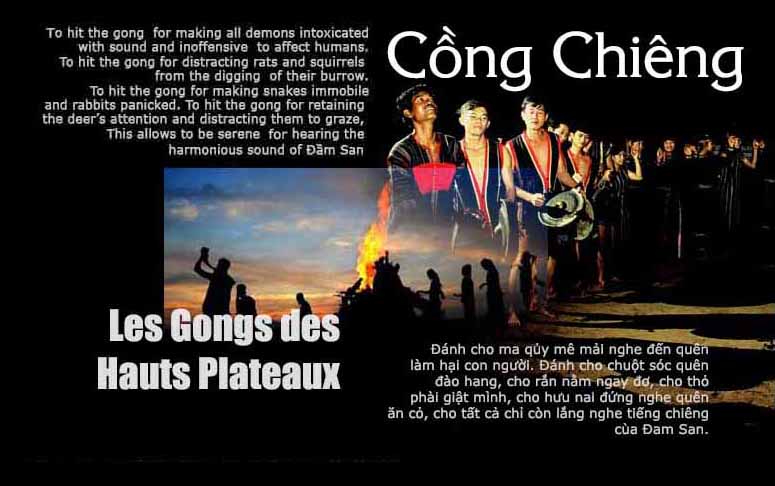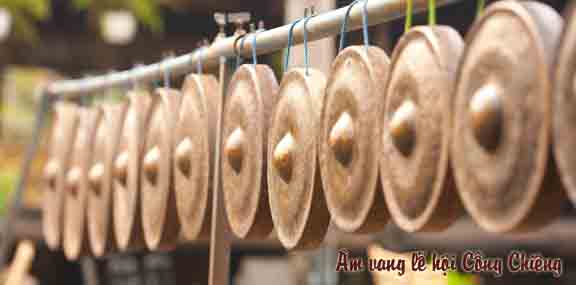 The culture of the gongs is localized in the 5 provinces of central Vietnam (Đắc Lắc, Pleiku, Kontum, Lâm Đồng and Đắk Nong). Some twenty ethnic groups (Bahnar, Sedang (Xơ Đăng), Mnongs, Cơ Ho, Rơ Mam, Êđê, Jarai (Giarai people), Radhes etc ..) are identified in the use of these gongs. According to illustrated Vietnamese musicologist Trần Văn Khê, in the other countries of Southeast Asia, the gong player always remains seated and can play several instruments associated at the same time. This is not the case of the gong players of Highlands in Vietnam. Each player may play a single gong. There are as many gongs than players in a set.
The culture of the gongs is localized in the 5 provinces of central Vietnam (Đắc Lắc, Pleiku, Kontum, Lâm Đồng and Đắk Nong). Some twenty ethnic groups (Bahnar, Sedang (Xơ Đăng), Mnongs, Cơ Ho, Rơ Mam, Êđê, Jarai (Giarai people), Radhes etc ..) are identified in the use of these gongs. According to illustrated Vietnamese musicologist Trần Văn Khê, in the other countries of Southeast Asia, the gong player always remains seated and can play several instruments associated at the same time. This is not the case of the gong players of Highlands in Vietnam. Each player may play a single gong. There are as many gongs than players in a set.
Thanks to a thin string or to a band of cloth that can be more or less tightened by torsion, each player suspends the gong to the left shoulder. He struck the central dome of the gong outer face either with a wooden or leather mallet or with his right fist barren or wrapped up in fabric.
The sound quality of the gong depends not only on the alloy with which the gong has been manufactured but also the tuner quality. Other parameters are involved: the wooden or leather mallet, the position and action of the hand striking the gong, the tension of the strap etc. . In addition, the player can modulate skillfully the effects of the gong sound by varying the pressure and the relaxation on the bent edge of the outer face with his left hand. The muting effect may be caused by this action. Each ethnic group prefer a type of wood in the manufacture of the mallet. By choosing the hard wood, the Êđê often obtain interference noise in the power of the gong resonance. By contrast, in selecting the soft wood, the Bahnar manage to obtain the « clarity » of its fundamental tone despite the weakness of intensity detected in the resonance.
At the time of the purchase, the gong is delivered to the « raw » state, without musical tone, character and soul. Its outer face is almost flat. It is similar to an object producing an audible signal. (Cái kẻng) Thanks to the strokes of wooden mallet and to fine hearing of the tuner, the gong receives small bumps and concentric circles on its border and on its inner and outer faces. The blow of the mallet given on its outer face increase its tone.
By contrast, the decrease of the resonance is visible inversely with its inner face. The gong tuner manages to give it a sound color, a particular musical note, which makes it now a musical instrument in its own right. According to the highland people, analogous to the man, the gong has a face, a character and a soul. It is unlike any other gong.It is said that the gong is educated because from an object that is purchased with the « raw » state from the Kinh (or Vietnamese) (Quảng Nam), it receives an education, a note, an ethnicity, a sacred character. For the gong purchased in Laos, it already has a soul but it is a Laotian soul.
To transform it into a gong of the high plateaus, it must be educated by the blows of wooden mallet so that it knows as well the language Bahnar, Stieng, Edê, Mnong etc. .. It now has the sacred soul (hồn thiêng) of the high plateaus.
The latter does not disappear as long as there is still the environment where the gong is « educated » (the forest, the ethnic groups, the villages, the sources of water, the animals etc. .. ). The sacred character of the gong can only be found in this natural environment which allows it to find its ethnic identity through the melodies varying from one village to another or from one ethnic group to another and the agrarian rites. The gong can produce a false note over the years of use. One says that it is « sick ».
It must be treated by bringing in a doctor (or a good musician tuner) that it is difficult to find sometimes on-site. It is necessary to travel several kilometers in other regions to succceed in finding him. Once readjusted the sound, it is said that the gong is healed.

